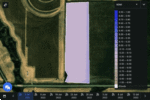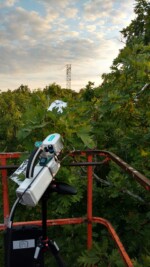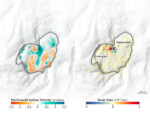
Tuesday, June 6th, 2023
When the dust that wafts off the Sahel and Sahara regions of Africa mixes with tropical clouds, it creates what’s known as a rainy “disturbance” in the eastern Atlantic. These disturbances are hurricanes in their youngest form, and as they travel across the ocean, they can either dissipate or grow into powerful storms. To study these

Monday, May 22nd, 2023
The most recent sea-level data from the U.S.-European satellite Sentinel-6 Michael Freilich indicates early signs of a developing El Niño across the equatorial Pacific Ocean. The data shows Kelvin waves, which are roughly 2 to 4 inches (5 to 10 centimeters) high at the ocean surface and hundreds of miles wide, moving from west to east along

Monday, May 8th, 2023
NOAA upgraded its Probabilistic Storm Surge (P-Surge) model—the primary model for predicting storm surge associated with high-impact weather like hurricanes and tropical storms—to version 3.0. This upgrade advances storm-surge modeling and forecasting for the contiguous United States (CONUS), Puerto Rico and the U.S. Virgin Islands, and comes just in time for the 2023 hurricane season beginning on

Monday, April 24th, 2023
Century-old sugar maples in Wisconsin. Five-hundred-year-old cedars in Oklahoma. Fifty-foot-wide oaks in Georgia. These trees grace our nation’s old-growth forests, and scientists say they hold unexplored mysteries from their roots to their rings. In an effort to steward these resources, on Earth Day 2022 the Biden Administration called upon the Department of Agriculture and the

Tuesday, April 11th, 2023
A NASA instrument to provide unprecedented resolution of monitoring major air pollutants—down to four square miles—lifted off on its way to geostationary orbit on April 7, 2023. The Tropospheric Emissions: Monitoring of Pollution (TEMPO) instrument will improve life on Earth by revolutionizing the way scientists observe air quality from space. “The TEMPO mission is about

Tuesday, March 28th, 2023
Despite an extreme drought in northwestern Iowa throughout summer 2022, the overall corn condition was better than in the previous two years. EOS Data Analytics explored the causes of these phenomena and explained how Iowa farmers tackle such prolonged dry conditions. During the last few decades, climate change had been bringing positive effects on crop

Saturday, March 11th, 2023
A NASA Earth-observing satellite has helped researchers track carbon dioxide emissions for more than 100 countries around the world. The pilot project offers a powerful new look at the carbon dioxide being emitted in these countries and how much of it is removed from the atmosphere by forests and other carbon-absorbing “sinks” within their borders. The

Tuesday, February 28th, 2023
In a new study, University of Missouri researcher Jeffrey Wood introduces the “ecosystem wilting point” concept, which explains how whole forests respond to drought. Wood and his research team found that when forests reach their ecosystem wilting point, they are less able to function properly, which includes their ability to absorb carbon dioxide. To learn

Saturday, February 11th, 2023
A team of international researchers, including one from NASA’s Jet Propulsion Laboratory, has combined satellite and archival imagery to show how one African city’s changing water usage influences land movements near and just below the surface. The new study zeroed in on Bukavu, a hillslope city in the Democratic Republic of the Congo. The researchers

Monday, January 30th, 2023
As of 2022, Brazil’s Munduruku Indigenous Reserve is the second worst-affected territory occupied by illegal miners in the country. In 2021, the illegal mining there grew by 363 percent within only two years, seizing hundreds and hundreds of lands. The situation with the Munduruku people is only one possible focal point to evaluate the scale
